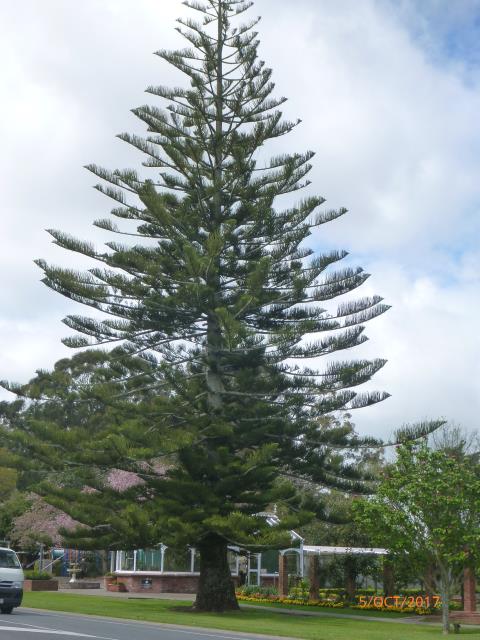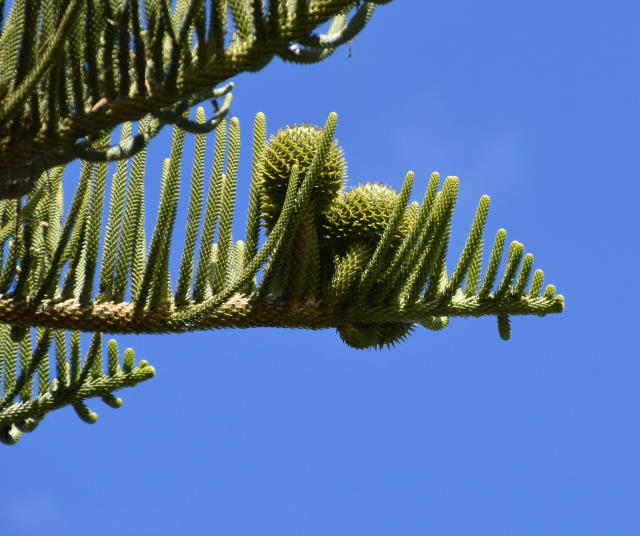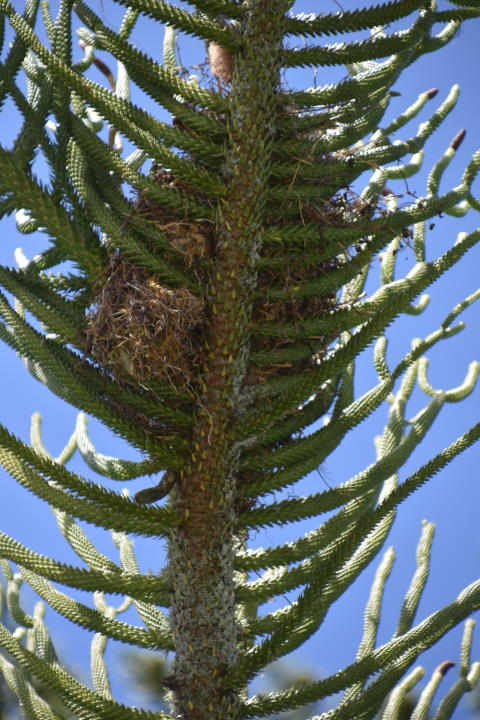
Araucaria heterophylla/excelsa
This is the beauty of the Araucaria family. A group of trees that encircle the Pacific Ocean, they include 13 different Pacific Island members of the genus, as well as the Chilean monkey puzzle, the Queensland bunya bunya pine, the Chinese and Japanese Cryptomerias, and several Tasmanian species, all of which are genealogically related to the giant sequoia of the western USA! All of them share a somewhat reptilian appearance with their bright green scaly leaves.
Standing alone in a garden, these sorts of trees often look stiff and out of place, whereas planted in clumps (or in their naturally occurring forests) they are magnificent. The monkey puzzle was, for a time, the darling of late Victorian England where it was often combined with ‘bogus-rustic arbours and geometrical beds of scarlet salvias.’ At much the same time in the USA, Brazil, Peru, and British colonies of the South Pacific the Norfolk pine, growing with the ‘hypnotic symmetry of a paper cut-out,’ was a favourite for the regimented planting of coastal esplanades. In New Zealand, Napier’s Marine Parade comes to mind and in Australia there is a magnificent example many kilometres long in the southwest town of Esperance. In less friendly climes it is grown as a house plant.
Few of the Araucaria family produce useful wood with the exception of the Brazilian Pirana pine, which makes excellent fine-textured timber for interior joinery and furniture. The Norfolk pine is good for woodturning and plywood. In 1774 when Captain Cook first saw the stands of Norfolk pine forest he hoped that it would be the answer to the British navy’s insatiable need for masts and spars. During the 17th and 18th centuries a cardinal point of British foreign policy was the expensive business of keeping the Baltic Sea open for the timber trade. An act was passed in 1704 to encourage the colonial trade in spars to make England independent of the Baltic. However it was soon found that Norfolk pine was not sufficiently resilient for the purpose, although our New Zealand kauri proved (unfortunately) to be a good candidate.
December 2020
A marvel is occurring in the Norfolk Pine near the Rose Garden in Thornton Road. It has become a veritable apartment block for sparrows; almost every branch has one if not two nests, with young birds shouting for food and parent birds coming and going constantly. Stand beneath its branches for a few minutes and witness what is happening up there.
This is not a true pine but a member of the genus Araucaria found across the South Pacific. It has squat, globose cones about 12 cm long and 14 in diameter (shown), which take 18 months to mature, releasing nut-like edible seeds. The Norfolk Pine is endemic to Norfolk Island, but land development means that even here it is now found mainly in the National Park. However it is widely planted around the world in places with a Mediterranean climate. Enjoying deep sand and tolerant of salt and wind, it is popular in coastal situations like Marine Parade, Napier, or the Esplanades of Busselton and Esperance in southern Western Australia. The most northerly specimen is probably on the island of Valentia off the southwest coast of Ireland. In Europe and North America it is usually grown as an indoor plant, and often used as a Christmas tree due to its symmetrical shape.
Its branches arise slightly obliquely from the trunk in regular whorls of five, forming ‘floors’. From each main branch the branchlets curve upwards like fingers, creating the perfect place for birds to nest (see picture). Indeed in Australia there is a gull which does not even bother to build a nest but lays its egg directly on the branch - a Partridge in a Pear Tree?



